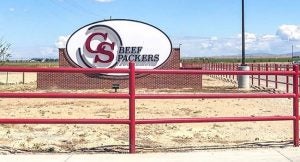Nestled in Kuna, Idaho, is CS Beef Packers, a meat packing plant built in 2017. CS Beef offers beef harvesting, fabrication, rendering, and hide processing. The facility was built following the formation of CS Beef Packers LLC in 2015, as a result of a partnership between Caviness Beef and JR Simplot Co.
Last year, I participated in a tour of the facility with the Idaho Cattle Association and explored a part of the beef industry that many people don’t fully understand. I have always been an animal agriculture advocate, but getting a behind-the-scenes look into a processing plant has made me a better advocate.
Here are the five biggest take-aways from the tour:
1) Taking photos is not permitted — a fact that my friend and I knew, however, we weren’t aware of the extent of this rule. I was there to write up a feature for Idaho Cattle Association’s Line Rider magazine, and she was there on a freelance assignment as well, so naturally, we wanted to get a photo of the CS Beef sign at the entrance. Before we could both grab a photo, a vehicle pulled up and a man emerged, questioning our intentions. We laughed at our rookie mistake; we both knew these plants have to be guarded against possible animal-rights activists, so we put our cameras away and were escorted in the vehicle to the check-in office.

2) It’s a surprisingly peaceful place. Although, the hallway that separated the visitor rooms and offices from the actual processing floor was concrete and bland, the workers were welcoming, the facility was structured and clean, and the kill floor was enclosed to ensure comfort and safety for workers, animals, and visitors. It was the most fascinating part of the industry I have had the privilege to get a behind-the-scenes-look into. None of it felt macabre.
3) JR Simplot partnered with Caviness, and has an embryo transfer lab inside the beef plant. In this office, we learned how they transfer embryos, and why. Their goal is to create better animals for slaughter, using both dairy cattle and beef cattle breeds. With their efficiency, the plant slaughters about 1,400 head of quality cattle per day.
4) Large square windows were placed throughout the hallway, giving visitors a glimpse into the steps of cattle processing. Each step of the process, from the point the cattle arrive, to the cuts of beef being shipped out to your local grocery store, or imported to other countries, was carefully supervised. Every worker had on PPE and were given appropriate breaks when needed. Supervisors were on each floor, and only the most highly trained personnel were given the difficult jobs — such as making the cuts on the carcasses and determining grade for each carcass. Our tour guides, CS Beef’s cattle buyer and plant manager, informed us that these employees were trained extremely well before being allowed to do any task asked of them. The strict guidelines put in place by the plant were to be followed and any discrepancies were caught by multiple checks and balances of the assembly line.
5) Seeing the hanging carcasses, the head of a cow hanging — just after the hair and hide were removed — waiting to be rendered for byproduct use, and knowing that, as we were speaking, cattle were being brought in and slaughtered, was nothing squeamish to me, surprisingly. These animals have served a purpose and have lived excellent lives, even to the point of the kill floor, where highly-trained professionals rotated throughout the day, and were put under even more supervision, in order to humanely harvest the cattle. The work was hard, to say the least, and, while our tour guides were joking and light-hearted the entire time, they took their jobs seriously, knowing the safety and well-being of animals and people, were in their hands.
Seeing this part of the industry is something every aspiring advocate should experience, it is a great way to pay respect to the animals that give us so much, and allows you to have open conversations with people who are misinformed and misguided on processing plants.
Markie Hageman majored in agribusiness at Fort Hays State University. She is actively involved in her state Cattlemen’s Association, Young Farmers chapter, and National Cattlemen’s Beef Association. Her AGDAILY.com articles can be found here.



